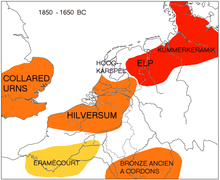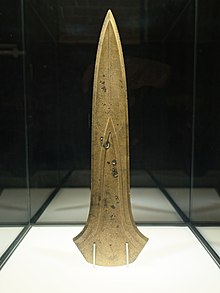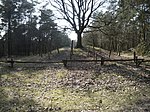
Hilversum is a city and municipality in the province of North Holland, Netherlands. Located in the heart of the Gooi, it is the largest urban centre in that area. It is surrounded by heathland, woods, meadows, lakes and smaller towns. Hilversum is part of the Randstad, one of the largest conurbations in Europe, and the Amsterdam metropolitan area; it is about 22 km southeast of Amsterdam's city centre and about 15 km north of Utrecht.

The Corded Ware culture comprises a broad archaeological horizon of Europe between c. 3000 BC – 2350 BC, thus from the late Neolithic, through the Copper Age, and ending in the early Bronze Age. Corded Ware culture encompassed a vast area, from the contact zone between the Yamnaya culture and the Corded Ware culture in south Central Europe, to the Rhine on the west and the Volga in the east, occupying parts of Northern Europe, Central Europe and Eastern Europe. Early autosomal genetic studies suggested that the Corded Ware culture originated from the westward migration of Yamnaya-related people from the steppe-forest zone into the territory of late Neolithic European cultures; however, paternal DNA evidence fails to support this hypothesis, and it is now proposed that the Corded Ware culture evolved in parallel with the Yamnaya, with no evidence of direct male-line descent between them.

A kurgan is a type of tumulus constructed over a grave, often characterized by containing a single human body along with grave vessels, weapons and horses. Originally in use on the Pontic–Caspian steppe, kurgans spread into much of Central Asia and Eastern, Southeast, Western and Northern Europe during the 3rd millennium BC.

The Bell Beaker culture, also known as the Bell Beaker complex or Bell Beaker phenomenon, is an archaeological culture named after the inverted-bell beaker drinking vessel used at the very beginning of the European Bronze Age, arising from around 2800 BC. Bell Beaker culture lasted in Britain from c. 2450 BC, with the appearance of single burial graves, until as late as 1800 BC, but in continental Europe only until 2300 BC, when it was succeeded by the Unetice culture. The culture was widely dispersed throughout Western Europe, being present in many regions of Iberia and stretching eastward to the Danubian plains, and northward to the islands of Great Britain and Ireland, and was also present in the islands of Sardinia and Sicily and some coastal areas in north-western Africa. The Bell Beaker phenomenon shows substantial regional variation, and a study from 2018 found that it was associated with genetically diverse populations.

A tumulus is a mound of earth and stones raised over a grave or graves. Tumuli are also known as barrows, burial mounds or kurgans, and may be found throughout much of the world. A cairn, which is a mound of stones built for various purposes, may also originally have been a tumulus.

Hoogkarspel is a village in the municipality Drechterland, located in the north west of the Netherlands, in the province of North Holland and the region of West-Frisia. The name derives from the words hoog and kerspel, a Middle Dutch word for parish.

The Wessex culture is the predominant prehistoric culture of central and southern Britain during the early Bronze Age, originally defined by the British archaeologist Stuart Piggott in 1938.

A gallery grave is a form of megalithic tomb built primarily during the Neolithic Age in Europe in which the main gallery of the tomb is entered without first passing through an antechamber or hallway. There are at least four major types of gallery grave, and they may be covered with an earthen mound or rock mound.
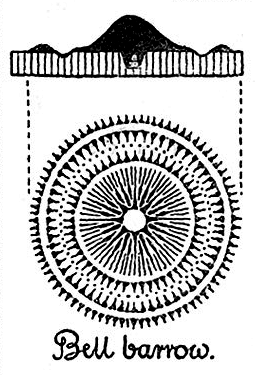
A bell barrow, sometimes referred to as a Wessex type barrow, campanulate form barrow, or a bermed barrow, is a type of tumulus identified as such by both John Aubrey and William Stukeley.

The Únětice culture, Aunjetitz culture or Unetician culture is an archaeological culture at the start of the Central European Bronze Age, dated roughly to about 2300–1600 BC. The eponymous site for this culture, the village of Únětice, is located in the central Czech Republic, northwest of Prague. There are about 1,400 documented Únětice culture sites in the Czech Republic and Slovakia, 550 sites in Poland, and, in Germany, about 500 sites and loose finds locations. The Únětice culture is also known from north-eastern Austria, and from western Ukraine.
The Deverel–Rimbury culture was a name given to an archaeological culture of the British Middle Bronze Age in southern England. It is named after two barrow sites in Dorset and dates to between c. 1600 BC and 1100 BC.
The Knighton Heath Period is the name given by Colin Burgess to a phase of the Bronze Age in Britain following the Bedd Branwen Period and spanning the period 1400 BC to 1200 BC. It was succeeded by the Penard Period.
The European Bronze Age is characterized by bronze artifacts and the use of bronze implements. The regional Bronze Age succeeds the Neolithic and Copper Age and is followed by the Iron Age. It starts with the Aegean Bronze Age in 3200 BC and spans the entire 2nd millennium BC, lasting until c. 800 BC in central Europe.
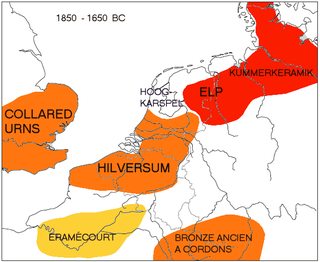
The Elp culture is a Bronze Age archaeological culture of the Netherlands having earthenware pottery of low quality known as "Kümmerkeramik" as a marker. The initial phase is characterized by tumuli, strongly tied to contemporary tumuli in Northern Germany and Scandinavia, and apparently related to the Tumulus culture in Central Europe. This phase was followed by a subsequent change featuring Urnfield (cremation) burial customs.

Bronze Age Britain is an era of British history that spanned from c. 2500–2000 BC until c. 800 BC. Lasting for approximately 1,700 years, it was preceded by the era of Neolithic Britain and was in turn followed by the period of Iron Age Britain. Being categorised as the Bronze Age, it was marked by the use of copper and then bronze by the prehistoric Britons, who used such metals to fashion tools. Great Britain in the Bronze Age also saw the widespread adoption of agriculture.

The Bronze and Iron Age cultures in Poland are known mainly from archeological research. Early Bronze Age cultures in Poland began around 2400–2300 BCE, while the Iron Age commenced in approximately 750–700 BCE. The Iron Age archeological cultures no longer existed by the start of the Common Era. The subject of the ethnicity and linguistic affiliation of the groups living in Central Europe at that time is, given the absence of written records, speculative, and accordingly there is considerable disagreement. In Poland the Lusatian culture, spanning both the Bronze and Iron Ages, became particularly prominent. The most famous archeological finding from that period is the Biskupin fortified settlement (gord) on the lake from which it takes its name, representing the Lusatian culture of the early Iron Age.
The Knovíz culture was an upper Danubian subgroup of the Late Bronze Age Urnfield culture, located mainly in Bohemia, Thuringia, and Bavaria. The eponymous type site for this culture, the Czech village of Knovíz, is located near Prague. The Knovíz culture was similar to the neighbouring Milavce culture, except for the funerary rites, which featured occasional skeletal burials as well as cremations.
Part of series of articles upon Archaeology of Kosovo

The prehistory of the Netherlands was heavily influenced by the region's constantly changing, low-lying geography. Inhabited by humans for at least 37,000 years, the landscape underwent significant transformations, from the last ice age's tundra climate to the emergence of various Paleolithic groups. The region witnessed the development of the Swifterbant culture, which was closely linked to rivers and open water, while the Mesolithic era saw the creation of the world's oldest recovered canoe, the Pesse canoe. The arrival of agriculture around 5000–4000 BC marked the beginning of the Linear Pottery culture, which gradually transformed prehistoric communities.
The Armorican Tumulus culture is a Bronze Age culture, located in the western part of the Armorican peninsula of France. It is known through more than a thousand burial sites covered by a tumulus or otherwise. The culture is renowned for some exceptionally richly endowed burials of chieftains of the time, which are contemporary with the elite of the Wessex culture, in England, and the Unetice culture, in Central Europe.
